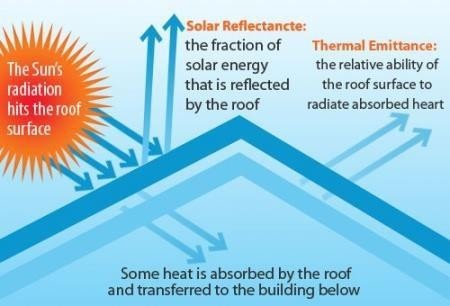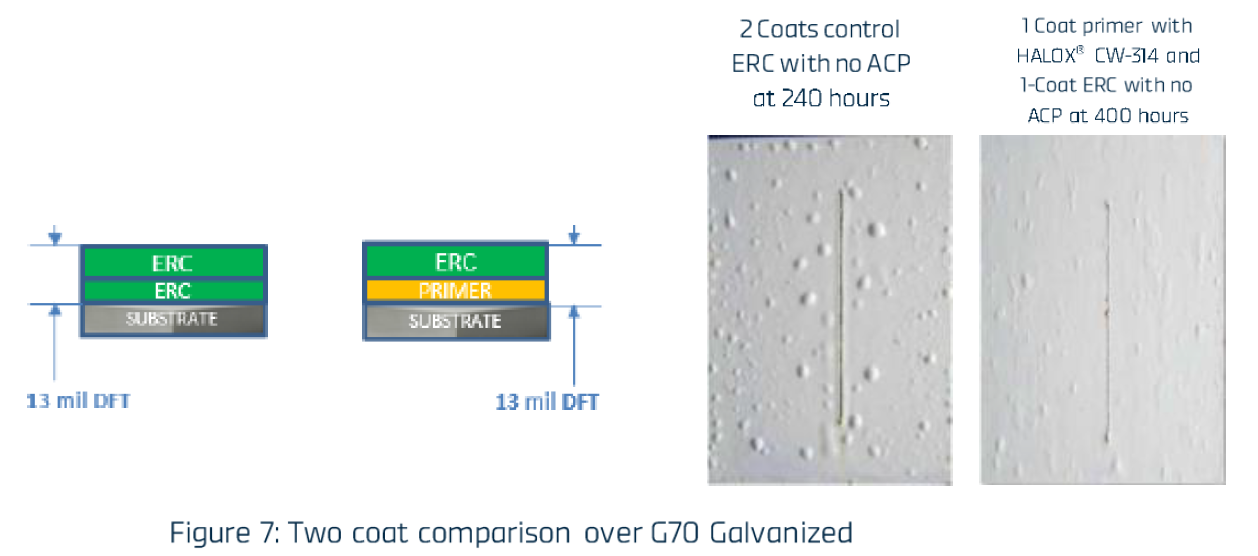Novel Additive for Anti-Corrosive Cool Roof Application

Summary
- Application: Paints & Coatings
- Additive: Anti-corrosive white pigment
- Key benefits: Enhanced solar reflectance ~ Reduced energy costs ~ Superior corrosion resistance~ Improved dirt pickup resistance ~ Low temperature flexibility ~ Direct to metal ~ Eco-friendly
Climate change and increasing urbanization are highlighting the issue of “urban heat islands” like never before.
Summers in a city can be several degrees hotter than the surrounding countryside due to an abundance of dark surfaces and roofs that act as heat reservoirs. Research has shown that installing cool roofs can help reduce heat buildup in cities, lowering maximum heat wave temperatures by more than 2°C. For individual buildings, cooler roofs deliver the following benefits:
- Reduction in energy bills due to reduced air-conditioning needs
- Improved thermal comfort of non-airconditioned indoor spaces
- Lower roof operating temperature prolongs roof service life

Environmental laws, requiring the use of energy efficient coatings, are being enforced in major metropolitan cities to help reduce heat build-up from the sun’s ultraviolet rays. The need to comply with local laws and consumer preference for greener solutions that help reduce their environmental footprint are driving demand for high-performance water-based coatings. The global elastomeric coatings market has been expanding with a compound annual growth rate of about 15%; it is expected to cross the $14 billion mark in 2022 (Figure 1).
The Challenge
Cool roof coatings must have high total solar reflectance (TSR) to reduce the urban heat island effect. TSR is the sum of solar reflectivity and thermal emittance. Solar reflectivity is the fraction of sunlight reflected by a surface; sunlight that is not reflected is absorbed as heat by the building. Thermal emittance is a measure of how efficiently a surface cools itself by emitting thermal radiation. The two properties of a surface, together, determine its TSR. Roof coatings must also have good dirt pick-up resistance against pollution, smog, and dust so that their high TSR is retained over an extended period of time.

In addition, roof coatings must extend the life of roofs by imparting superior corrosion resistance to metal. Enhanced corrosion resistance in roof coatings can help lower maintenance costs and reduce landfill waste by reducing roof tear- offs. Preferably, the enhanced corrosion resistance properties should come without the need for an extra coat and avoid use of heavy metals in the formulation.
The challenge for formulators of elastomeric roof coatings (ERC) is to offer cost effective, long -lasting, corrosion resistant coatings that address environmental concerns. These coatings must tick all the following checkboxes:
- Avoid use of expensive IR pigments to reflect solar radiation
- Offer superior dirt pick-up resistance to retain the high TSR over time
- Avoid use of heavy-metal corrosion inhibitors
- Avoid the need of a secondary primer layer for corrosion protection
The Solution
HALOX® CW-314 is a non-toxic, heavy metal free, anti-corrosive pigment suitable for use in both water borne, and solvent borne protective coating systems. It increases the total solar reflectance (TSR) of the coating while maintaining the dirt pick-up resistance (DPUR). A study was conducted to compare the solar reflectance and corrosion resistance properties of HALOX® CW-314 in a white elastomeric roof coating against a traditional primer and topcoat system. Table 1 shows the ERC formulations with HALOX® CW-314 and the traditional water based elastomeric coating used as control. The two formulations are practically identical except for the substitution of about 5% HALOX® CW-314 in place of an equal weight percentage of calcium carbonate.
Solar reflectance
Figure 3 compares the total solar reflectance percentage of the two white ERCs on a low slope roof. The initial TSR of HALOX® CW-314 is more than 2% greater than that of the control coating. The difference increases further to about 4% after the coatings are allowed to pick up dirt from the environment. Figure 4 compares the coating TSR on a high slope roof and further confirms that the coating with HALOX® CW-314 exhibits higher reflectance than the control formulation.
Corrosion resistance
Corrosion resistance of the coatings was tested by performing the salt spray test (ASTM B-117). Coated sheets of metal were scribed and exposed to 5% NaCl solution inside a fog chamber at 35°C. The extent of corrosion was examined periodically to determine the number of hours until coating failure.
Figure 5 shows the corrosion test results of white elastomeric roof coatings for low slope applications. The dry film thickness (DFT) applied was 13mils. The results show that a single coat of the control ERC failed after only 96 hours with corrosion around the scribe and blisters all over the coating. The coating formulated with HALOX® CW-314 showed corrosion around the scribe after 206 hours with isolated blisters. Even after 336 hours in the fog chamber, the HALOX® CW-314 coating did not show heavy blistering.
Figure 6 compares the corrosion resistance of a two-coat application of the control ERC over an ACP primer to a single coat of ERC formulated with HALOX® CW-314. The control coating failed after 144 hours in the fog chamber with heavy blistering. The coating with HALOX® CW-314 showed superior corrosion resistance and developed only isolated blisters even after 336 hours.

Figure 7 compares the corrosion resistance of two coats of the control ERC against a primer containing HALOX® CW-314 topped with a single coat of ERC with no ACP. The results show that the control system developed severe blistering after 240 hours while the system with HALOX® CW-314 showed moderate blistering after 400 hours. In order to demonstrate the utility of HALOX® CW-314 beyond roof -coatings, the study also compared the corrosion inhibition properties of HALOX® CW-314 in a water-based epoxy formulation and a water reducible alkyd coating.

Figures 8 and 9 show that the coatings with HALOX® CW-314 allowed lower corrosion over an extended period of time as compared to coatings without the HALOX® corrosion inhibitor.
Low Temperature Flexibility
HALOX® CW-314 adds low temperature flexibility to coatings which helps prevent cracking in colder climates.
Coatings with HALOX® CW-314 pass ASTM D6083, the standard specification for liquid applied acrylic coatings used in roofing applications. It resists weathering for more than 1000 hours under ASTM G155 conditions which measure the resistance of a nonmetallic material to simulated sunlight and moisture exposure.
Conclusions
Coatings formulated with the patent-pending, multi-functional technology of HALOX® CW-314 show higher total solar reflectance due to greater surface area. The high TSR reduces the amount of heat absorbed by the building, lowering the energy required for cooling and mitigating the urban heat island effect. The improved dirt pickup resistance of coatings with HALOX® CW-314 helps maintain the higher TSR for an extended period of time.
HALOX® CW-314 imparts superior corrosion resistance properties to roof coatings without the need for a p rimer coat. The primeless application reduces installation and inventory costs while enhancing the corrosion resistance to extend the life of the roof (Figure 10). Coatings with HALOX® CW-314 show good low temperature flexibility which helps prevent cracking in colder climates
HALOX® CW-314 is a white non-refractive pigment (Refractive Index = 1.6) suitable for both white and colored roof coatings. It has a small particle size and a high surface area. which makes it easy to disperse. It can be used alone or in combination with other non-toxic corrosion inhibitors and mineral pigments in the formulation of environmentally friendly specialty paints. HALOX® CW-314 is generally regarded as safe (GRAS) and contains no heavy metals. The green technology is especially suited for systems where 21 CFR 175.300 approval or conformance to ANSI/NSF standards is required.
Request a sample of HALOX® CW-314 today from here.
Disclaimer: Information made available herein is provided for general informational purposes only and not guaranteed to be complete, up-to-date, or accurate in all respects. You should not rely on any information contained herein in making any decision, taking any action or refraining from taking any action. This information is not intended to be a substitute for any technical, regulatory, legal or other professional advice, in the relevant jurisdiction, on any subject matter. All information is made "as is" with no guarantee as to its accuracy or completeness, and without any claim, representation or warranty of any kind (express or implied), including without limitation, any warranties of suitability, reliability, applicability, merchantability, fitness, noninfringement, result, outcome or any other matter. We expressly disclaim all liability in respect to actions taken or not taken based on any of the contents herein. © 2021 ICL Specialty Products Inc. All rights reserved.
All information is protected under international copyright conventions.


